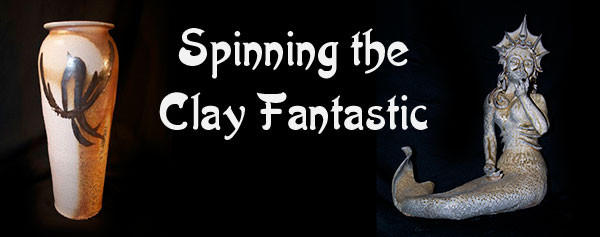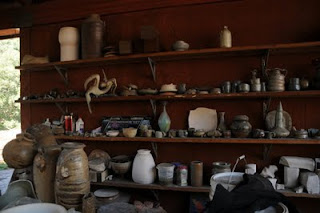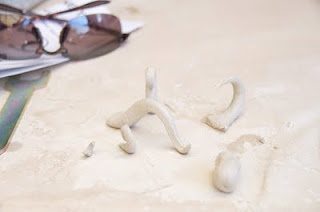 This is my wheel. Yes, it's been a long time since I've cleaned the wheel, the wall and the area around it. I think that it will finally be cleaned up when I move, but who knows when that will be... sigh...
This is my wheel. Yes, it's been a long time since I've cleaned the wheel, the wall and the area around it. I think that it will finally be cleaned up when I move, but who knows when that will be... sigh... These are my tools. I love my tools! There tools on the top are trim tools and ribs. The ribs are used for shaping. The trim tools are, obviously, for trimming. Most of these need to be sharpened or replaced. I've had them for a long time.
These are my tools. I love my tools! There tools on the top are trim tools and ribs. The ribs are used for shaping. The trim tools are, obviously, for trimming. Most of these need to be sharpened or replaced. I've had them for a long time. My lovely heat gun. This isn't the industrial strength heat gun that is my actual favorite, but it's still very good. (The industrial strength one is somewhere else, not sure where...) I use the heat gun to dry out my pieces when they get too wet (not a good thing as clay will flop over if it gets too wet). There are other reasons to use a heat gun, which I will get into later.
My lovely heat gun. This isn't the industrial strength heat gun that is my actual favorite, but it's still very good. (The industrial strength one is somewhere else, not sure where...) I use the heat gun to dry out my pieces when they get too wet (not a good thing as clay will flop over if it gets too wet). There are other reasons to use a heat gun, which I will get into later.
Ok, this is what I threw tonight. My good friend, Emma, wants a tagine. Now, I had a bit of an issue with forming the channel on the bottom part. The channel is where the lid rests and for some reason, I couldn't picture it in my head. Once I could, I had a hard time making my hands do what they needed to do to form a channel. Another excuse: I worked out for the first time in a long time yesterday and I'm all achy. I worked out my shoulders and upper body, so I was kind of weak. Both the top and the bottom are kind of off-center which makes me annoyed. However, as most people will tell you, no one ever puts their pots on a lazy susan or a something that spins so you can never see how off center a pot is.
 Tomorrow, I will flip over the lid and form the top of the tajine, basically throwing both the top and the bottom of the lid, if that makes sense. I have to make sure I don't let the pieces get too dry or it will be hard to form the top of the lid properly.
Tomorrow, I will flip over the lid and form the top of the tajine, basically throwing both the top and the bottom of the lid, if that makes sense. I have to make sure I don't let the pieces get too dry or it will be hard to form the top of the lid properly.Oh, and when I talk about trimming, you see how the bottoms of these pieces are not exactly neat? Well, trimming takes care of that. I might not have to trim the lid of the tajine if I do this right...
























